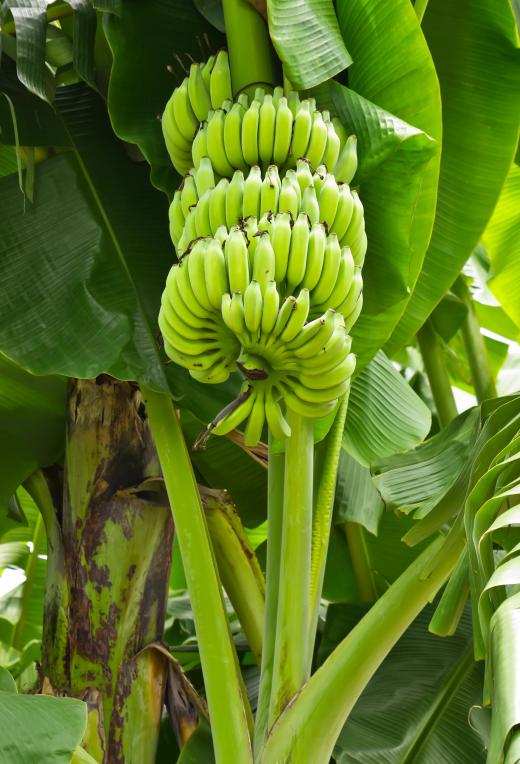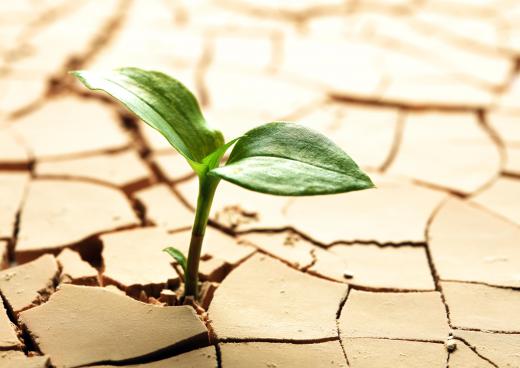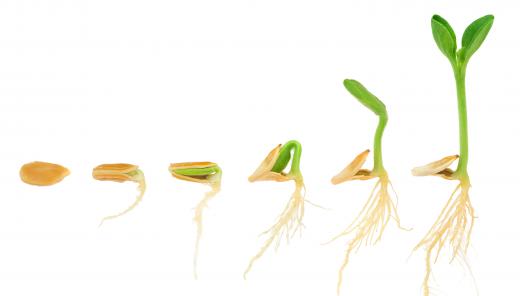What Is Ethylene Biosynthesis?
Ethylene is a compound of carbon and hydrogen with the chemical formula C2H4. It is a colorless gas with a sweet odor that is manufactured on a huge scale by the petrochemical industry for use mainly in the production of plastics. Ethylene is also produced by plants and acts as a hormone that influences crucial plant processes in a number of ways. It is unusual for such a small molecule to be active as a hormone. Ethylene biosynthesis in plants takes place in response to various stresses, including attack by pests and diseases, drought and damage to tissue.
The effects of ethylene on plants are many and varied. Its best-known effect is in hastening the ripening of some kinds of fruit, for example apples, bananas and tomatoes, but not citrus fruit. It had been known since at least the time of the ancient Egyptians that some fruits could be ripened more quickly by bruising; it is often only necessary to bruise or cut one fruit to accelerate the ripening of a large number stored in the same container. Ethylene was not identified as the cause of this response until 1901 and it was only in the late 20th century that details of the process of ethylene biosynthesis in plant tissue were revealed.

Ethylene inhibits flower production in most plants, but promotes seed germination and can influence seedling development in an interesting way, known as the “triple response.” Seedlings grown in dark conditions and exposed to ethylene show a characteristic thickening and shortening of the stem, and increased curvature of the apical hook — a structure that protects the growing center at the tip of the stem. Ethylene also promotes destruction of chlorophyll, production of pigments called anthocyanins — associated with autumn colors — and aging and shedding of leaves. Since the compound is a gas, and — like most hormones — is effective at very low concentrations, it can diffuse easily through plant tissue, and so production of this compound by one plant can affect others nearby. Ethylene from industrial sources and car engines can also affect plants.

The starting point for ethylene biosynthesis in plants is methionine, an essential amino acid produced in the chloroplasts. This reacts with adenosine triphosphate (ATP) to produce S-adenosyl-L-methionine (SAM), also known as S-AdoMet, catalysed by an enzyme called SAM synthetase. A further reaction converts SAM into 1-amino-cyclopropane-1-carboxylic acid (ACC), catalysed by the enzyme ACC synthase. Finally, ACC reacts with oxygen to produce ethylene, hydrogen cyanide and carbon dioxide, catalysed by the enzyme ACC oxidase. The hydrogen cyanide is converted to a harmless compound by another enzyme, so ethylene biosynthesis does not release any toxic chemicals.

ACC synthase is produced by plants in response to stress, causing more ACC, and consequently more ethylene, to be produced. The stress may take the form of attack by insect pests or plant diseases, or it may be due to environmental factors such as drought, cold or flooding. Harmful chemicals can also result in stress, leading to ethylene production.

The plant hormone auxin, if present in large amounts, stimulates ethylene production. Auxinic herbicides, such as 2,4-dichlorophenoxyacetic acid (2,4-D), mimic the action of this hormone, causing ethylene production in many plants. While the exact mode of action of these herbicides is not clear, it seems that excessive ethylene production may play a role in plant death in susceptible species.

The purpose of ethylene biosynthesis in plants is, as of 2011, an area of active research. Given the wide range of effects of this hormone, it is likely that it has multiple roles. In the case of seedlings, it seems to be produced in response to resistance from the soil to the developing seedling and to trigger growth responses that help protect the growing center. There is also evidence that it may play a role in disease resistance; experimental studies suggest that plants lacking an ethylene response are more susceptible to some diseases.
AS FEATURED ON:
AS FEATURED ON:















Discuss this Article
Post your comments